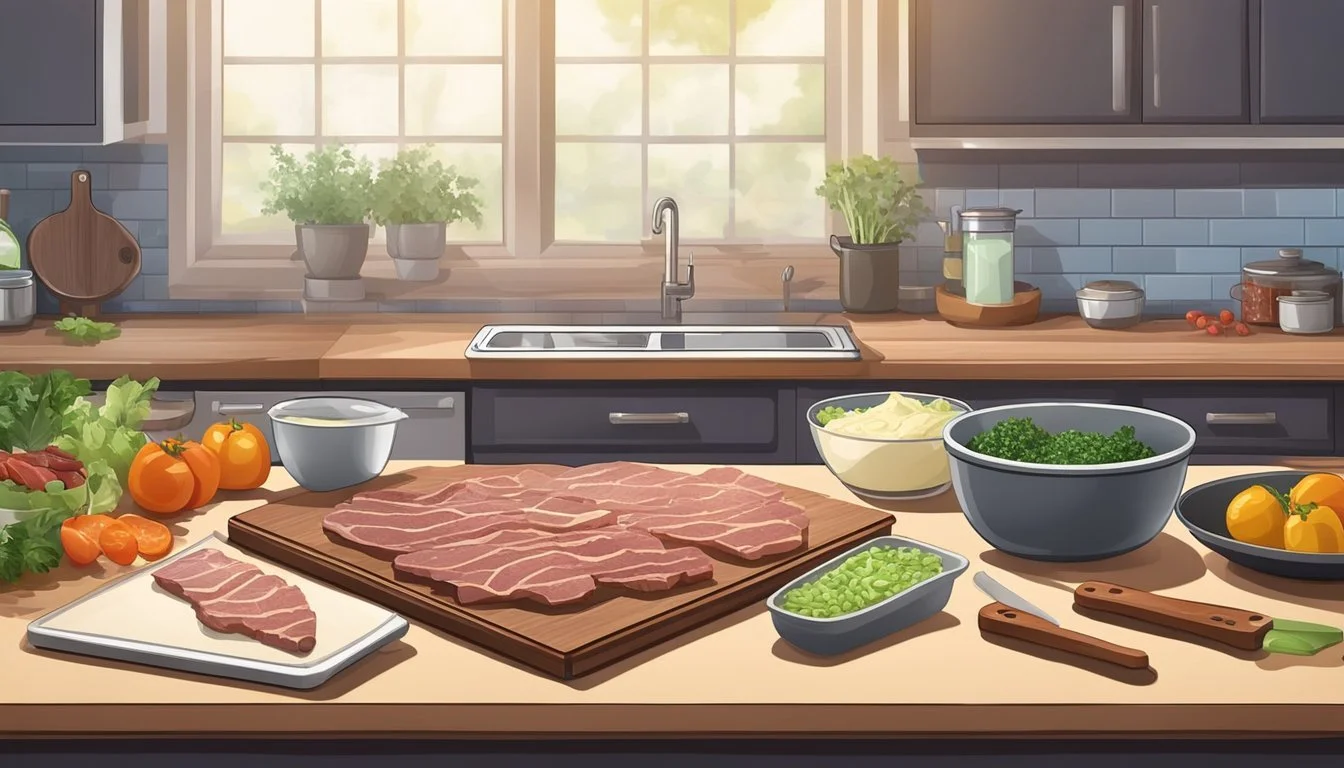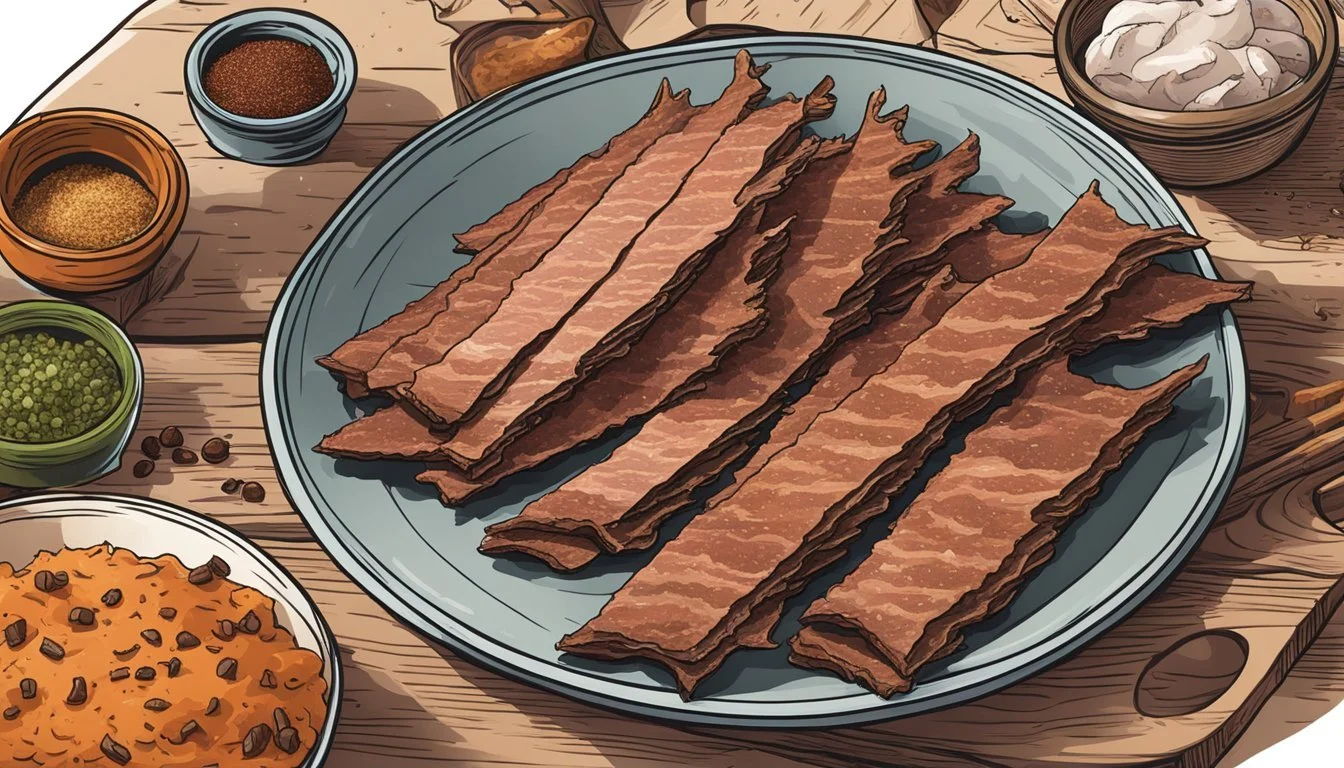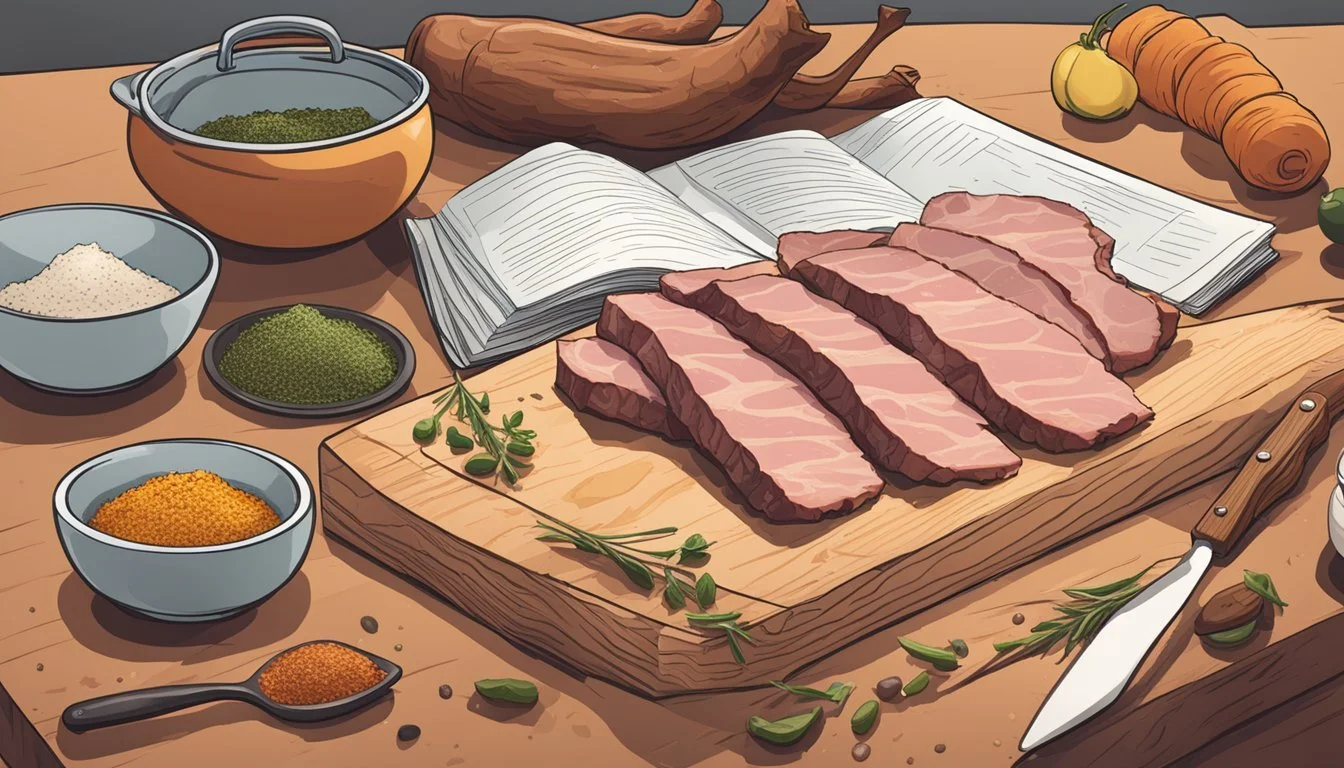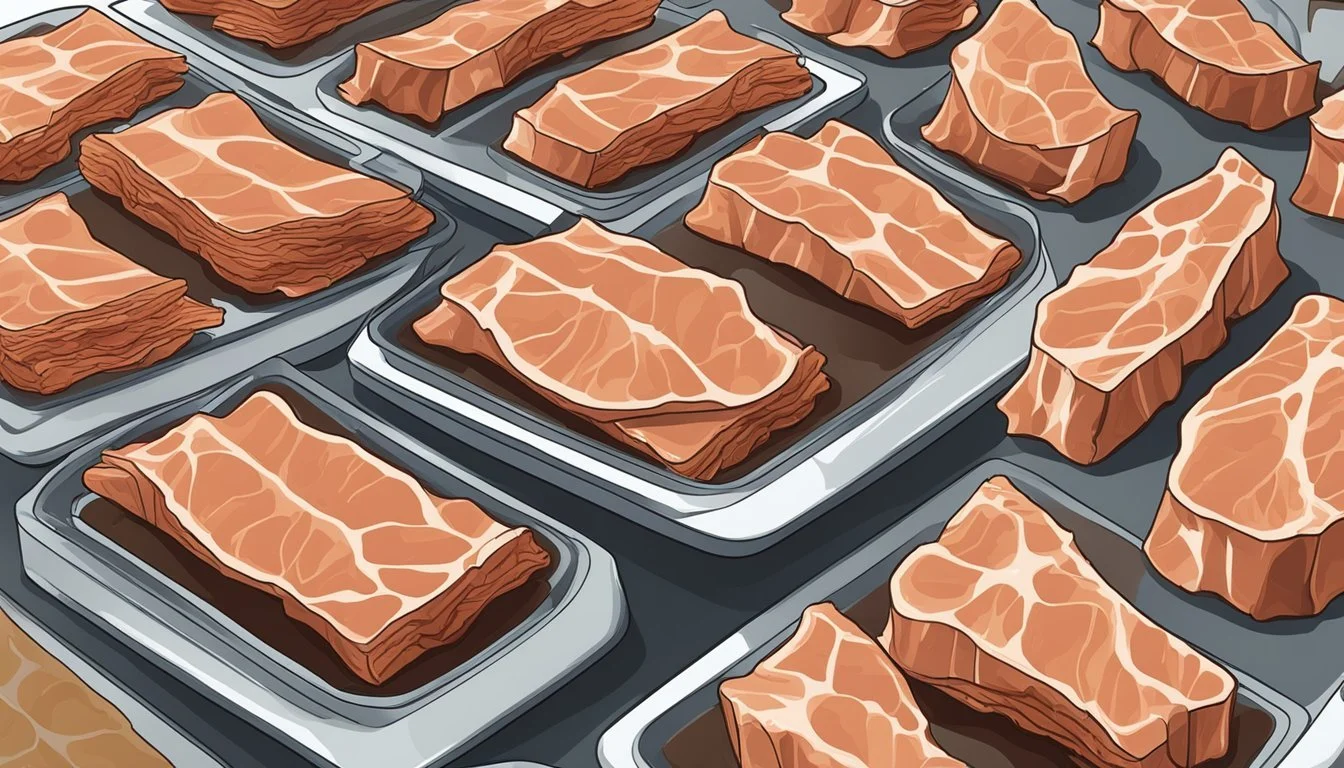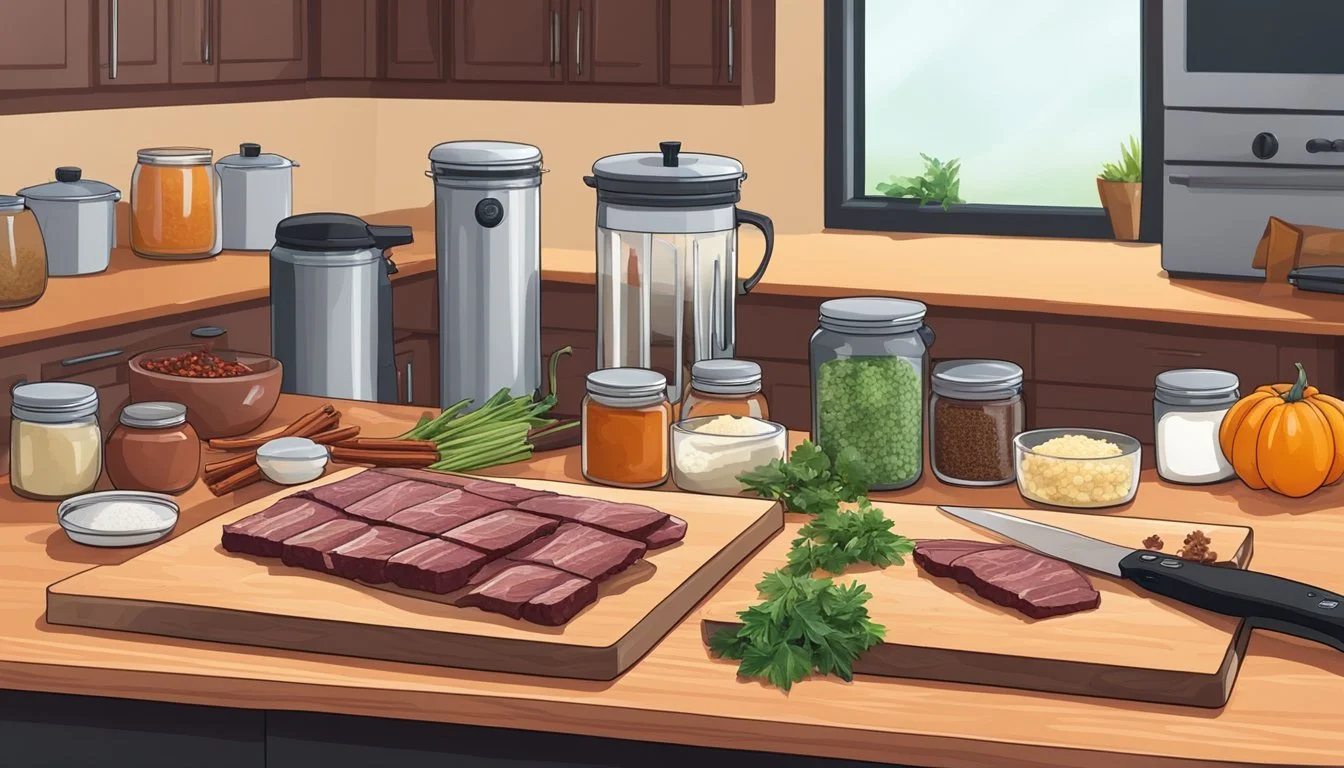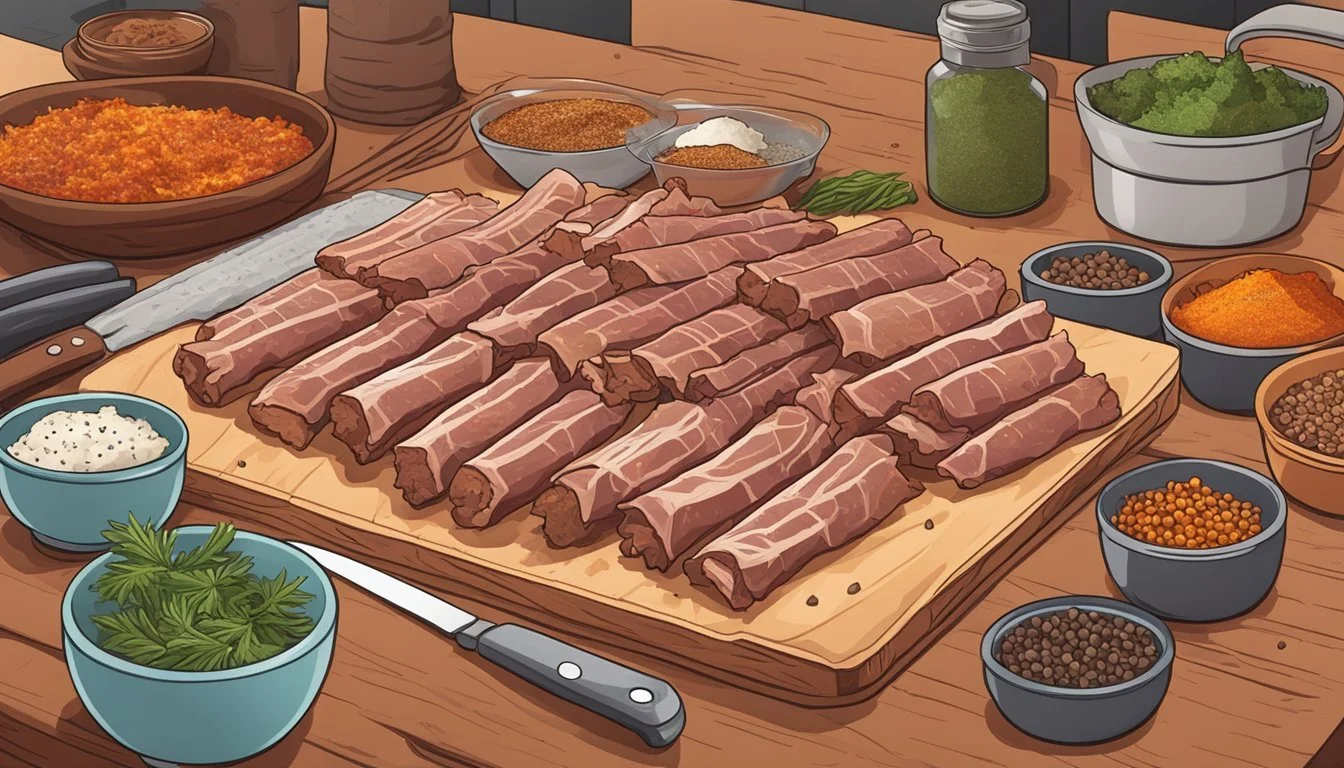DIY Pork Jerky
Your Go-To Recipe for Homemade Snacks - Easy and Flavorful
DIY pork jerky is a venture into the world of homemade snacks (What wine goes well with snacks?), where both the flavor and the nutritional value are in your own hands. Pork jerky offers a protein-rich and savory option that serves as an ideal snack for those looking for something that's both satisfying and portable. Making pork jerky at home allows for complete control over ingredients, cuts of meat, and the level of seasoning, ensuring a snack that's tailored to personal tastes and dietary needs.
The process of making pork jerky involves selecting the right cut of pork, typically a lean one to avoid excess fat, which can spoil the jerky. The meat is then sliced into thin strips, marinated with a mixture of choice seasonings and, depending on the method, either baked at a low temperature, smoked, or dehydrated until it achieves a chewy, yet tender texture.
For enthusiasts of do-it-yourself projects and culinary experiments, homemade pork jerky is an excellent opportunity to explore a new recipe. It's simple enough for beginners to try their hand at, yet customizable enough for the seasoned chef to experiment with. By following food safety guidelines and precise steps, anyone can produce a batch of fresh, flavorful pork jerky in their own kitchen.
Selecting Your Pork: The Best Cuts for Jerky
Choosing the right cut of pork is crucial for quality jerky. Pork tenderloin is often preferred for its leanness, leading to a tender result, while pork loin is a close alternative. How you handle the cut, from preparation to storage, influences the final snack's texture, flavor, and safety.
Identifying Lean Cuts
Lean cuts of pork, like pork tenderloin, are ideal for jerky because they contain less fat. Fat can cause the jerky to spoil faster. Pork loin is also suitable, offering a good balance between leanness and flavor.
Preparing Your Meat
Properly slicing the meat is essential; thin strips, around (1/8) inch thick, cut against the grain, will dry evenly and provide the perfect chew. Trimming any excess fat off these slices further ensures a high-quality jerky.
Comparing Pork Jerky to Beef and Other Meats
Pork jerky stands out for its rich flavor and is a great alternative for those who prefer not to eat beef. Compared to beef jerky or elk jerky, pork provides a unique taste and can be a leaner option when using cuts like tenderloin.
Marinating for Flavor and Tenderness
Marinades often include soy sauce and garlic to infuse the pork with flavor. Marinating also helps tenderize the meat. For the best results, pork should be left to marinate in the refrigerator for at least a few hours, or preferably, overnight.
Safety and Storage Precautions
Storage is crucial for maintaining the quality of homemade jerky. After drying, cool the jerky to room temperature, then place it in an airtight container. To extend shelf life, you can freeze the jerky, preventing spoilage and pathogens from affecting food safety.
Hygiene and Food Safety in DIY Jerky Preparation
Maintaining cleanliness throughout the jerky-making process is non-negotiable. All surfaces and tools should be sanitized before use to prevent contamination. Always wash hands thoroughly when handling meat to avoid introducing bacteria that could compromise food safety and the quality of your homemade jerky.
Crafting Your Jerky Marinade
The success of pork jerky hinges on the marinade, a flavorful bath that not only seasons the meat but also infuses it with moisture and tenderizes it. Crafting the perfect marinade requires attention to flavor balance, marination time, and a willingness to experiment with different taste profiles.
Balancing Flavors in Your Marinade
A well-balanced marinade for pork jerky hinges on a combination of salty, sweet, and savory elements with a touch of spice. For a traditional approach, start with:
Soy sauce or Worcestershire sauce: Provides a deep umami base.
Brown sugar or honey: Adds a hint of sweetness and helps create a pleasant glaze during drying.
Garlic powder and onion: Offer a savory backdrop.
Salt: Essential for flavor and preservation.
When mingling these ingredients, aim for harmony where no single flavor overpowers the others.
Achieving the Perfect Marinade Duration
The duration of marination is crucial to achieving jerky that is both flavorful and properly textured. Typically, pork should marinate for:
Minimum: 2 hours
Optimal: Overnight (up to 24 hours)
Longer marination periods allow the flavors to penetrate more deeply, but be mindful of overly salty ingredients which can cure the pork too heavily if left for extended periods.
Exploring Sweet, Savory, and Spicy Variations
Diverge from the classic jerky recipe by experimenting with a variety of spices and seasonings to cater to different palates:
Sweet Variations: Incorporate sesame oil and additional honey or sugar to enhance sweetness.
Savory Twists: Infuse the marinade with chipotle peppers or smoked paprika for a smoky, savory character.
Spicy Kicks: Boost the heat with chili flakes, cayenne pepper, or freshly ground black pepper for those who prefer a tang of spice.
Adjust the ratios to suit personal preference, and always ensure the meat is well-coated to absorb the complex flavors of the marinade.
Drying Techniques: Oven Vs. Dehydrator
Selecting the right technique to dry pork jerky is crucial for both flavor and texture. The two primary methods include using an oven or a food dehydrator, each with its own set of advantages and necessary conditions for optimal results.
Using Your Oven Effectively
To dehydrate pork jerky in an oven, one must set it to the lowest temperature, typically around 160°F to 180°F. It is advisable to place the marinated pork slices on cooling racks set over baking sheets lined with parchment paper to facilitate airflow. This setup contributes to an even drying process without the need for a specialized appliance.
The Advantages of a Food Dehydrator
A food dehydrator excels due to its consistent heat distribution and controlled environment. It offers the advantage of a more uniform drying process, ensuring each piece of jerky reaches the same level of dehydration. Moreover, dehydrators generally consume less energy and can handle larger quantities of meat at a time, making them ideal for bulk preparation.
Determining Optimal Drying Times and Temps
The duration it takes to dry pork jerky greatly depends on the thickness of the meat slices and the specific appliance used. Here’s a quick guide for reference:
Thin slices (1/8 inch or less): 4-6 hours
Medium slices (1/4 inch): 6-8 hours
Thick slices (1/2 inch or more): 8-10 hours
For ovens, maintain a low temperature within the aforementioned range and check periodically to avoid over-drying. In contrast, dehydrators should be set at a consistent temperature, typically at 155 to 160 degrees F for the durations mentioned above.
By following these guidelines, one can ensure their pork jerky is dehydrated to perfection, whether using an oven or a dehydrator.
Slicing and Seasoning
To ensure the ideal texture and flavor for homemade pork jerky, one must give special attention to slicing the pork and meticulously choosing and applying the seasonings.
Mastering the Thickness and Texture
Slicing the pork uniformly is crucial for even drying and an appealing texture. Using a sharp knife, one should cut the meat against the grain to a thickness of about 1/8 to 1/4 inch. This range is optimal because it allows the jerky to dry properly while remaining pliable. To achieve uniform slices easier, partially freezing the pork can make it firmer and easier to slice. If necessary, a rolling pin can be used to gently even out thicker slices between two sheets of parchment paper.
Adding Spices and Seasonings
A carefully crafted blend of spices and seasonings is what makes jerky a flavorful snack. Start with a base of salt, which is essential for both flavor and preservation. Black pepper adds a classic piquancy, while spices like smoked paprika can introduce a subtle smokiness.
Here's a simple spice blend one might use:
Salt: 2 tablespoons
Black Pepper: 1 tablespoon, freshly ground
Smoked Paprika: 2 teaspoons
Combine the spices in a small bowl and apply them to the pork strips evenly. After seasoning, the pork should marinate for several hours, preferably overnight, to allow the flavors to penetrate the meat. This also helps the jerky achieve a uniform flavor profile and enhances the final product's palatability.
Finishing Touches: Texture and Taste
The final stages of preparing homemade pork jerky are crucial for achieving the right mouthfeel and flavor profile. It's where the art and science of jerky making culminate.
Achieving the Desired Consistency
To ensure the pork jerky is dry but not overly tough, one needs to dehydrate it to a pliable texture. This is typically accomplished by drying the pork in an oven, dehydrator, or smoker until it bends without breaking. A consistent temperature of around 160°F is generally recommended for dehydrating meat. Keep a close eye during the last hours of dehydrating to prevent over-drying, as this can lead to brittle jerky that lacks moisture and flexibility.
The target is jerky that is semi-dry to the touch on the outside and chewy yet comfortable to eat on the inside. The dehydrating process should be precise:
Dehydrator: Place marinated and pat-dried pork on trays without overlap.
Oven: Set slices on a rack in a preheated oven, initially at a higher temperature such as 325°F for a brief period, then lower the heat for the remaining time.
Smoker: Utilize woods like hickory, cherry, apple, or maple for subtle to bold tastes.
Flavor Profiling: Sweet, Smoky, Spicy
Flavor pairing defines the jerky's palate appeal and creates profiles ranging from sweet to spicy to smokey. Incorporate liquid smoke if a smoked essence is desired without an actual smoker. Selecting different woods like chipotle for spicy undertones or fruitier woods for a hint of sweetness can influence the flavor profile significantly.
Marinades and seasonings applied before the dehydration process concentrate in flavor as the meat dries. A flavor balance can include elements of:
Sweetness: Achieved with brown sugar or honey.
Smokey: Liquid smoke or smoked paprika can be added.
Tang: Vinegar or citrus adds a sharpness.
Spicy: Crushed chilies or hot sauce for heat.
Experimenting with different combinations and ratios of these ingredients allows for a tailored tasting experience. Always evenly coat the pork with the marinade and allow sufficient time, ideally overnight, for the flavors to infuse before starting the dehydration process.
Storage Solutions for Homemade Jerky
Proper storage is pivotal in ensuring the longevity and taste of homemade jerky, with a focus on maintaining dryness and preventing spoilage.
Extending Jerky Shelf Life
The shelf life of homemade pork jerky is primarily influenced by the method of storage. For best results, jerky should be kept in an airtight container to prevent exposure to moisture and air, which can accelerate spoilage. If the jerky is to be consumed within a short period, a standard refrigerated environment can suffice, as cooler temperatures slow down the degradation process.
Room Temperature: Store in a cool, dark place for up to 1-2 weeks.
Refrigerated: Keeps well for several weeks.
Freeze: For long-term storage, freezing jerky extends its shelf life for several months.
They must ensure the jerky is completely cool before placing it in any container to avoid condensation.
Packaging and Preservation Tips
Packaging jerky correctly is essential for maintaining freshness and texture. Individuals can consider using vacuum-sealed bags, which remove air and significantly lengthen the time homemade jerky remains fresh.
Vacuum-Sealed Bags: Best choice for minimizing air exposure.
Freezer Plastic Bags: Effective for freezing, but ensure to squeeze out excess air before sealing.
Desiccant Packets: Include these in your storage container to absorb any residual moisture.
For optimal storage, people should distribute jerky in single layers within the chosen container to facilitate even air circulation and discourage bacterial growth. It's recommended that they check storage containers periodically for any signs of moisture and consume jerky within the appropriate timeframe based on their chosen storage method.
Nutritional Considerations
When preparing pork jerky, it's essential to be aware of its nutritional profile, specifically its calorie content and macronutrient distribution. Homemade pork jerky can be a high-protein, low-carbohydrate snack, but the nutritional content will vary depending on the ingredients and preparation methods used.
Caloric and Macronutrient Content
Pork jerky is predominantly known for its high protein content, which is beneficial for muscle repair and satiety. The exact calorie count varies, but it generally provides a concentrated energy source due to its low moisture content. Below is an approximate breakdown of the caloric and macronutrient content in a typical serving of pork jerky based on common ingredients:
Calories: A single ounce of pork jerky typically contains about 70 to 100 calories.
Protein: This amount of jerky usually offers 9 to 15 grams of protein, branding it as a high-protein snack.
Carbohydrates: Carbohydrates are minimal in pork jerky, often less than 5 grams per ounce, making it a low-carb option.
Fat: The fat content can range from 1 to 5 grams, with efforts made to trim away visible fat to reduce saturated fat content.
Cholesterol and Sodium: Cholesterol levels depend on the cut of pork used, while sodium content can be significant due to marinades and seasonings aimed at flavor enhancement and preservation.
Fiber: Typically, pork jerky contains no dietary fiber unless specific ingredients high in fiber are added to the seasoning or marinade.
Inherently, pork jerky is a shelf-stable and convenient source of nutrients, but individuals should consume it in moderation, especially if managing sodium or saturated fat intake.
Advanced Jerky Making: Variations and Techniques
For those looking to elevate their homemade jerky game, mastering international flavors, experimenting with various meats, and crafting unique spice blends are essential techniques. This section will guide the reader through expanding their jerky repertoire beyond traditional recipes.
International Flavors: Bak Kwa and Others
Bak Kwa, also known as Chinese pork jerky, is a sweet and savory delicacy featuring a unique blend of fish sauce, sesame oil, and often a touch of Chinese five-spice. Homemade Bak Kwa can be elevated by incorporating sesame seeds into the marinade, enhancing the jerky's texture and flavor profile.
Ingredients for Bak Kwa Marinade:
Sesame oil
Shaoxing wine or a dry sherry
Sesame seeds (optional)
Preparation: Marinate thin slices of pork in this mixture before baking or dehydrating to create a chewy, flavorful snack reminiscent of the traditional street fare found in parts of Southeast Asia.
Experimenting with Wild Game
Venison, elk, and bison offer an adventurous departure from classic beef jerky. When making elk jerky or other game jerky, it's important to trim any excess fat as it can turn rancid and affect both the texture and taste of the final product.
Basic Game Jerky Recipe:
2 lbs game meat (sliced thinly across the grain)
Marinade of choice (consider bold seasonings to complement the rich game flavors)
Technique: Due to its lean nature, game meat may dry faster, so one should monitor the dehydration process closely to prevent the jerky from becoming too tough.
Creating Signature Jerky Blends
Developing a signature jerky blend allows for creativity and customization. One can start with a basic beef jerky recipe and then modify seasonings to create a distinct taste.
Liquid bases (soy sauce, Worcestershire sauce)
Sweeteners (brown sugar, honey)
Spices and Herbs (garlic powder, onion powder, black pepper)
Method: Combining these elements in different ratios can yield anything from a spicy kick to a subtle smokiness. For DIY jerky enthusiasts, the key is to taste and adjust the marinade as needed before soaking the meat strips.
Tasting and Review: Savoring Your Creation
After the hours spent drying, the pork jerky is ready for the most rewarding part—tasting. Before indulging, allow the jerky to cool to room temperature. This rest period isn't just about not burning one's mouth; it lets the flavors settle and the texture to reach its ideal state of chewiness.
When tasting, one should first note the aroma. It often gives the first hint of the spices used during marination. Upon biting into a piece, the jerky should yield a firm yet pliable texture. The balance between dryness and moisture is crucial: too dry and it becomes tough, too moist and it won't have that satisfying chew.
Flavor Profile
Savory: Is there a strong umami essence?
Sweet: How does any sweetness complement the meat's natural flavors?
Heat: Does the spiciness enhance or overwhelm?
A thoughtful review reflects on texture contrast and how the flavor develops with each chew. The maker might notice the subtlety of smokiness if a smoker was used, or the nuances brought out by oven drying versus a dehydrator.
Reviewing Your Jerky:
Aroma: Is it inviting and indicative of the seasoning?
Texture: Is it the right balance of chewy and tender?
Seasoning: How well do the salt, sweet, and spicy elements integrate?
One shouldn't hesitate to note any areas for improvement on their homemade jerky. Perhaps adjusting the drying time, or tweaking the marinade for the next batch. Each iteration brings one closer to perfection in creating a snack that is both flavorful and satisfying.
Troubleshooting Common Jerky Making Issues
Making jerkies like pork jerky at home can be a rewarding process, but sometimes even experienced jerky makers face problems like over-drying or under-drying, as well as seasoning challenges after drying. This section looks into various issues that may arise during the jerky-making process and provides solutions to ensure the final product is both safe to consume and palatable.
Dealing with Over-Drying and Brittleness
When pork jerky becomes too dry or brittle, it often results from too much time in the oven, smoker, or dehydrator. One must closely monitor the jerky after the initial few hours of drying:
Check Consistency: Jerky should not snap readily; it should bend and show signs of white fibers when done.
Hydration Tip: If the jerky is over-dried, place it in a sealed container with a damp paper towel to slightly rehydrate without making it soggy.
Managing Under-Dried Jerky Risks
Under-dried jerky poses a risk of spoilage due to inadequate removal of moisture. To reduce the risk:
Temperature Setting: Ensure the dehydrator or oven is preheated to the correct temperature of approximately 160°F.
Check Regularly: Test for doneness by bending a piece of jerky; it should crack but not break.
Preservation Concern: When in doubt, use an oven method at the end of the dehydration cycle to ensure thorough drying.
Adjusting Flavors and Seasonings Post-Drying
The flavor profile of pork jerky can sometimes require adjustment even after the jerky has been dried. Adjusting sweetness, tang, salty taste, or spice after dehydrating can involve the following:
For increased sweetness: Gently brush a light honey glaze on the jerky and then heat it in the oven for a few minutes.
Boosting salty or spicy flavors: Sprinkle fine salt or dry spice mix onto the surface, press in gently, and if needed, place jerky under a broiler for a minute or two.
Enhancing tang: In case the jerky lacks tang, spraying a light vinegar solution and drying in the oven for a short time can enhance the flavor profile.
By addressing these issues, one can fine-tune the drying process and flavor enhancement to achieve the perfect batch of homemade pork jerky.
Final Thoughts
Making homemade pork jerky is a savory journey towards snacking independence. One has the luxury of tailoring flavors and harnessing the satisfaction of creating quality jerky from scratch. They are in control of the ingredients, ensuring that the jerky is free from preservatives and tailored to personal tastes.
When they make pork jerky, it's essential to:
Select the right cut, favoring lean meats.
Slice the pork consistently across the grain for an even texture.
Marinate with a mixture of choice ingredients to infuse flavors deeply.
The drying process is critical. The cook must ensure:
The oven or dehydrator is at the lowest setting, typically 160°F to 180°F.
Air circulation surrounds the meat entirely for uniform drying.
The jerky reaches a state where it is dry and firm yet pliable.
Once the pork jerky is done, it's crucial to:
Cool it completely before storage.
Store in an airtight container to maintain freshness.
A person's efforts culminate in a stash of quality jerky — a healthier snack option that rivals commercial counterparts. Their batch represents the epitome of bespoke snacking, a testament to craftsmanship and a nod to culinary prowess. Homemade pork jerky isn’t just food; it's a craft that satisfies with every bite.

